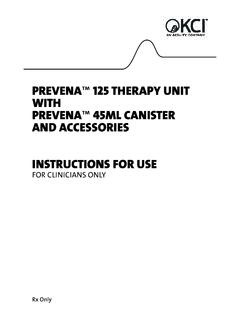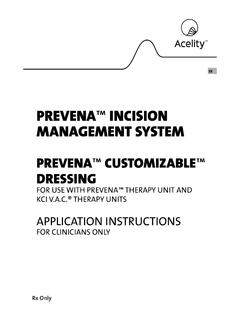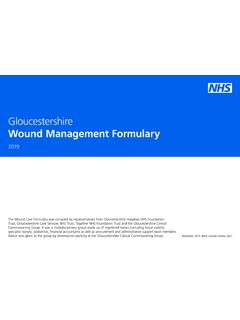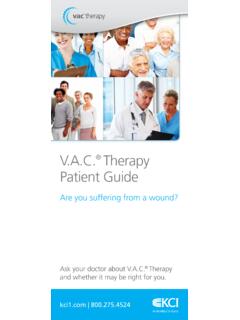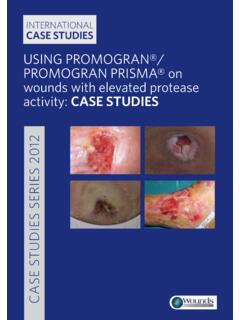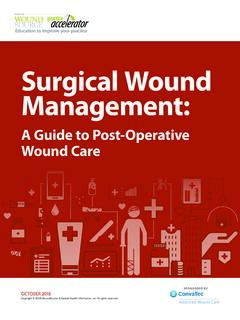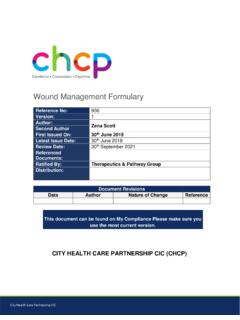Transcription of CLINICAL GUIDELINES - Acelity
1 THERAPY. CLINICAL GUIDELINES . A REFERENCE SOURCE FOR CLINICIANS. Rx Only This copy supercedes any TABLE OF CONTENTS. previous revision. For revision Introduction 5. level and contact information, refer to back cover of Points to Remember When Using Therapy 6. these GUIDELINES . Therapy Safety Information 7. Indications for Use 7. These GUIDELINES are not intended as a guarantee Contraindications 8. of results, outcome or Warnings 9. performance of the Precautions 13. Therapy System. They Additional Precautions for GranuFoam Silver Dressing 15. are recommendations to help clinicians establish patient- Considerations for Transitioning Therapy Into Home Care 16. specific treatment protocols. As with any application, please The Family of Therapy Units 17. consult the patient's treating 1 - Therapy System 19. physician about individual Therapy System Pressure Settings 19. conditions and treatment, dressings , Canisters and Disposables 21. and follow all applicable instructions for use and 2 - Dressing General GUIDELINES 23.
2 Labeling for product use Ensuring Dressing Integrity 23. and operation. Non-Adherent dressings 23. Always consult sections of Maintaining a Seal 24. this guideline along with the Changing the Canister 24. applicable instructions for use, Disconnecting from the Therapy Unit 25. labeling and safety information 3 - Specific Dressing Techniques 27. sheet for the specific Therapy Unit and Techniques for Treating Multiple Wounds 27. dressing type before placing a Techniques for Tunneling and Sinus Tracts 29. System on a patient. Undermining 30. Foot Wounds 31. For a medical emergency, contact your local emergency Orthopedic Hardware 32. number (911). If you have any wound Edge Reapproximation and Dressing Technique 33. questions about operation or dressings and Fecal Incontinence 33. use, contact your local KCI. Dressing Small Wounds and Pad Application 34. representative. For further information, visit Incision Management 35. or call 4 - Therapy Monitoring 37. 1-800-275-4524. Pain Management 37.
3 CAUTION: Federal ( ) Length of Treatment 37. law restricts these devices to When to Discontinue Therapy 37. sale / rental by or on the order Indicators of Effective Therapy 38. of a physician. Indicators of Ineffective Therapy 38. Rx Only Minimal Changes in wound Size 38. Deterioration of the wound 39. Changes in wound Color 40. wound Odors 41. 3. 5 - wound Specific Information 43. Acute / Traumatic Wounds / Partial-Thickness Burns 43. Dehisced Wounds 45. Meshed Grafts 46. Pressure Ulcers 48. Management of a Patient with a Pressure Ulcer Using Therapy 49. Diabetic Foot Ulcers 50. Treatment of Diabetic Foot Ulcer (DFU) with Therapy 51. CLINICAL Considerations for Diabetic Foot Ulcers 52. Venous Insufficiency Ulcers 52. Chronic Wounds 53. Flaps 54. Flap Dressing Application with Therapy 55. Enteric Fistula 56. 6 - Additional Information for Therapy 61. Therapy and Hyperbaric Oxygen (HBO) Therapy 61. dressings and Diagnostic Imaging 62. Therapy and Magnetic Resonance Imaging (MRI) 62. Ordering the Therapy System 63.
4 Transitioning Patients Between Care Settings 64. KCI Contact Information 64. 7 - Therapy Unit and System Disposables 65. Therapy Essentials 65. Index 69. 4. INTRODUCTION. Vacuum Assisted Closure ( ) Therapy is an advanced wound healing therapy that can be readily integrated into the clinician's wound healing practice, to help optimize patient care. This advanced wound healing technology is coupled with microprocessor-controlled therapy units, specialized dressings and 24 hours a day, 7 days a week technical support. The Therapy platform includes a collection of products: , , ATS , Freedom , Simplicity , and Negative Pressure wound Therapy Systems. These integrated wound management systems are designed to deliver negative pressure (a vacuum) to promote wound healing by preparing the wound bed for closure, reducing edema, promoting granulation tissue formation and perfusion and by removing exudate and infectious materials. The components of the Therapy System work as an integrated product to optimize both the delivery and the benefits of negative pressure wound therapy.
5 An open pore reticulated polyurethane foam ( GranuFoam Dressing GranuFoam Silver . Dressing), or polyvinyl alcohol foam ( WhiteFoam Dressing) is cut to fit the wound , then covered with an adhesive drape. The open cells of the foam enable equal distribution of the negative pressure across the surface of the wound , while tubing transfers accumulated fluids to the Canister. The software-controlled therapy unit applies negative pressure to the wound bed. The user can select continuous or intermittent / Dynamic Pressure Control (DPC). therapy on the therapy unit, depending upon wound type and the needs of each patient. (Therapeutic Regulated Accurate Care) technology delivers, monitors and helps to maintain target pressure and relays signals to the therapy unit. The safety features of the Therapy System include alarms that signal tubing blockages, a full or missing canister, inactive therapy, low battery, leaks in the seal of the dressing and a low pressure alarm in the , and Therapy System models.
6 5. These GUIDELINES do not address application procedures or CLINICAL considerations specific to KCI's Therapy System when using VeraFlo Therapy mode (instillation of topical solutions). Contact your KCI Representative and consult product specific instructions for use and labeling for guidance on use with application of VeraFlo Therapy. These GUIDELINES do not address application procedures or CLINICAL considerations specific to KCI's Negative Pressure Therapy (NPT) device for management of the open abdomen (the ABThera Active Abdominal Therapy System). Contact your KCI Representative and consult product specific instructions for use and labeling for guidance. POINTS TO REMEMBER WHEN USING THERAPY. Ensure that the patient / wound is a suitable candidate for Therapy. Read and follow all user instructions and safety information that accompany KCI products. Ensure accuracy of diagnosis and address all underlying and associated co-morbidities. Ensure appropriate Dressing selection and suitable indication-specific dressings are used.
7 Do not place GranuFoam dressings or WhiteFoam dressings directly over exposed organs, blood vessels, anastomotic sites and / or nerves. Ensure appropriate debridement prior to treatment. Do not tightly pack dressings into the wound ; place dressings gently into the wound . Ensure a good drape seal has been achieved. The , and . Therapy Systems offer a Seal Check Leak Detector that provides assistance in identifying leaks. Always count the total number of pieces of foam used in the wound . Document the foam quantity and dressing change date on the drape or Foam Quantity Label if available, and in the patient's chart. Keep Therapy on for at least 22 hours in a 24 hour period. Do not leave the Dressing in place if the therapy unit is switched off for more than two hours in 24. Monitor continuously and check and respond to alarms. When dressing is removed, count the number of foam pieces removed, correlate the count with the number of pieces previously placed in the wound and verify the complete removal of all Foam dressing pieces.
8 If no response or improvement in the wound is observed within two weeks, reassess the treatment plan. Seek advice / support from local KCI representative as needed. Follow Standard Precautions. 6. THERAPY SAFETY INFORMATION. Disposable components of the Therapy System are provided as indicated on the associated product labeling. Therapy Unit canisters are packaged sterile or fluid path sterile and are latex-free. All disposable components of the Therapy System are for single use only. To help ensure safe and effective use, the GranuFoam Dressing, GranuFoam Silver Dressing and WhiteFoam dressings are to be used only with Therapy Units. Re-use of disposable components may result in wound contamination, infection and / or failure of the wound to heal. The decision to use clean versus sterile / aseptic technique is dependent upon wound pathophysiology, physician / clinician preference, and institutional protocol. IMPORTANT: As with any prescription medical device, failure to consult a physician and carefully read and follow all therapy unit and dressing instructions and safety information prior to each use may lead to improper product performance and the potential for serious or fatal injury.
9 Do not adjust therapy unit settings or perform therapy application without directions from / or supervision by the treating physician. INDICATIONS FOR USE. The , , ATS and Freedom , Simplicity and Negative Pressure wound Therapy Systems are integrated wound management systems for use in acute, extended and home care settings. When used on open wounds, they are intended to create an environment that promotes wound healing by secondary or tertiary (delayed primary) intention by preparing the wound bed for closure, reducing edema, promoting granulation tissue formation and perfusion and by removing exudate and infectious material. Open wound types include: chronic, acute, traumatic, subacute and dehisced wounds, partial-thickness burns, ulcers (such as diabetic, pressure or venous insufficiency), flaps and grafts. The GranuFoam Silver Dressing is an effective barrier to bacterial penetration and may help reduce infection in the above wound types. When used on closed surgical incisions, they are intended to manage the environment of surgical incisions that continue to drain following sutured or stapled closure by maintaining a closed environment and removing exudates via the application of negative pressure wound therapy.
10 7. CONTRAINDICATIONS. Do not place foam dressings of the Therapy System directly in contact with exposed blood vessels, anastomotic sites, organs or nerves. NOTE: Refer to Warnings section for additional information concerning Bleeding. Therapy is contraindicated for patients with: Malignancy in the wound Untreated osteomyelitis NOTE: Refer to Warnings section for Osteomyelitis information. Non-enteric and unexplored fistulas Necrotic tissue with eschar present NOTE: After debridement of necrotic tissue and complete removal of eschar, Therapy may be used. Sensitivity to silver ( GranuFoam Silver Dressing only). 8. WARNINGS. Bleeding: With or without using Therapy, certain patients are at high risk of bleeding complications. The following types of patients are at increased risk of bleeding, which, if uncontrolled, could be potentially fatal: Patients who have weakened or friable blood vessels or organs in or around the wound as a result of, but not limited to: Suturing of the blood vessel (native anastamoses or grafts) / organ Infection Trauma Radiation Patients without adequate wound hemostasis Patients who have been administered anticoagulants or platelet aggregation inhibitors Patients who do not have adequate tissue coverage over vascular structures If Therapy is prescribed for patients who have an increased risk of bleeding complications, they should be treated and monitored in a care setting deemed appropriate by the treating physician.


